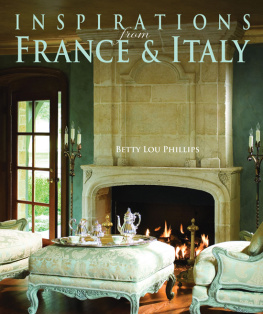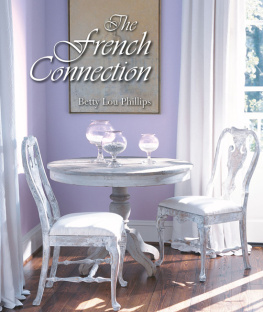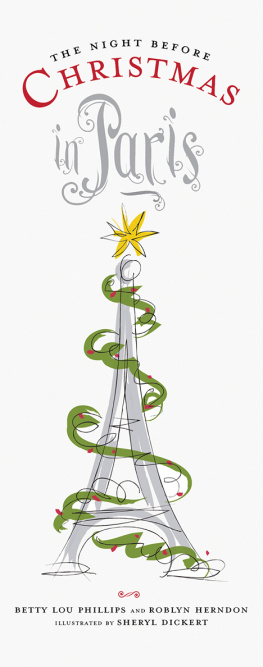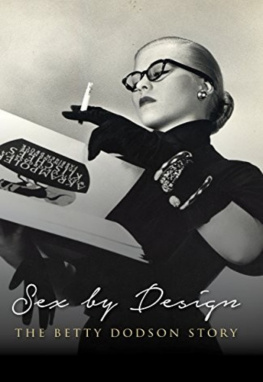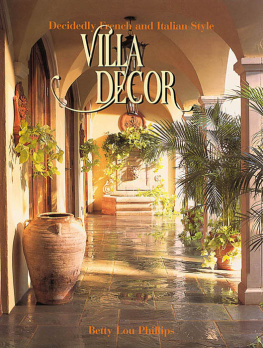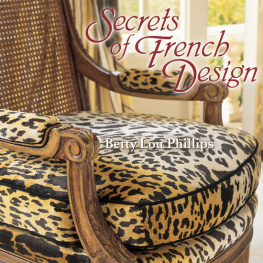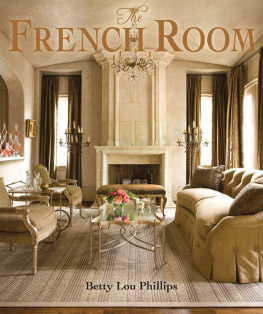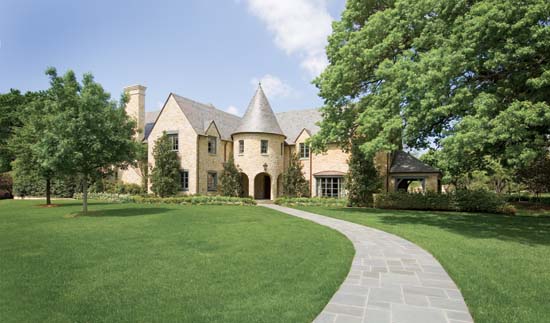All rights reserved. No part of this book may be reproduced by any means whatsoever without written permission from the publisher, except brief portions quoted for purpose of review.
Acknowledgments
One of the nicest aspects of writing a book is the opportunity to meet and get to know so many interesting people. Special thanks, therefore, goes to those from New York to California who opened the doors to their splendid chateaux, palazzi, villas and vacation homes and permitted us to photograph their residences: Maria and Michael Ainbinder, Anita and Thurman Arnold, Candi and Dr. Rick Blau, Jo Beth and Berry Cash, Pam and Tim Culver, Ruth Ann and Mark Dunn, Kim and Scott Martin, Connie and Bill McNally, Connie and Brooks Noah, Ellen and John Rutherford, Bridget and Jim Tanner, Meredith and Bill Tichenor and more.
I appreciate, too, the effort the following designers put into creating the alluring, satisfying rooms that make up this book: Shannon Bowers, Dan Brady, Cathryn Chapman, Laura Lee Clark, Holly Lydick, Stephanie Moore, Connie McNalley, Linda McCormick, Constance Noah, Christina Phillips, Marilyn Phillips and Mary Lee Singer.
Also, I am personally grateful to those who facilitated the timely completion of homes so my own projects could become an integral part of this book. Actually, we might still be shooting were it not for Donna Burley, Laura Elms, Mark Farmer, Esther Gandal, Jesus Marroquin, Philip Minton, Jodie Newby and Linda Swain, who often accomplished the incredible, rallying to this cause. Special thanks also go to Jennifer Chapman, Frieda Heath, Angela Malone, Ron Mutcher and Jayne Taylor.
It truly takes a village to produce a book. For her invaluable research support, I thank Janice Stuerzland for their prized design assistance, I thank Tara Kohlbacher, Julie Macatee, Andrea Smith and Missy Williams. Also, I'd like to express my gratitude to photographer Dan Piassick for his patience, open-mindedness and, most importantly, talent, to say nothing of his amazing rapport with animals, which certainly helped make our photo shoots successful.
Add to the above list a love and appreciation for my long-time editor, Madge Baird, and her admirable team. Also, I sincerely thank you, the reader, for so kindly inviting Inspirations from France & Italy into your home.
As if defining good taste, bolts of icy, candlelight hues from the fabric house of Christopher Hyland swathe an ottoman and a pair of bergre chairs from the Cameron Collection, Dallas. During the reign of Louis XV (171574), the French armchair with exposed wood frame, soft flowing lines and closed upholstered sides made a grand entrance. The sterling silver tea service is from the Italian firm Buccellati, revered for superb artisanship.
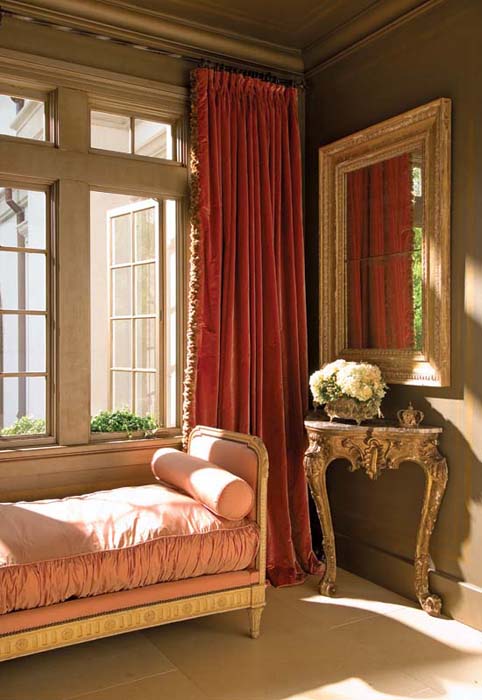
Sophisticated silk velvet curtains, edged in a Scalamandr trim, and a vintage rcamier from Shabby Slip, New Orleans, capture the romance of Italy. A portrait of Madame Rcamier by French artist Jacques-Louis David hangs in the Louvre. Emperor Napolon Bonaparte (17691821) exiled the provocative Parisian madame in 1805; however, after his defeat at Waterloo in 1815, she returned to the city and resumed her salon.
Introduction
One picture is worth ten thousand words, says a Chinese proverb. And it is safe to say that the familiar adage proves true. A room in print worthy of Paris's beguiling Right Bank or of Florence, the heart of the Tuscany region where the presence of artists Leonardo da Vinci and Michelangelo still looms, catches knowing eyes and almost surely inspires creative minds.
But the power of pictures isn't new. Hundreds of years ago, scattered Native American tribes speaking various languages painted pictographs on cave walls, rocks, and hides to communicate their thoughts, needs and feelings. Nowadays images spread across the glossy pages of widely read shelter magazines and coveted design books have equally grand, if different, ambitions. With pitching imitation as the sincerest form of flattery decidedly last-century, most savvy publications reflecting luxury lifestyles appear intent, instead, on urging readers to fashion their own unmistakably swank empires, whether chteaux , villas or palazzi.
Never mind that in bastions that want for nothing, a coterie of magnetic antiquesexquisite tapestries, dramatic chandeliers and storied armoires set amid sensuously sculpted statuaryare expected fixtures. Or that their signature siblingsswaths of fabrics from prestigious European mills replete with attention-grabbing passementerie are just as likely the focus. All look equally at home on this side of the Atlantic as they do overseas and, more importantly, fulfill an American penchant for timeless grandeur that never wanes.
Lately, though, it seems that old-world artistry is not enough for a sizable and growing number of design aficionados. For many of us, satisfaction comes from creating cosmopolitan glamoura chic blend of the traditional and edgy with a downtown attitude apt for an era with more choices than ever.
After dismissing polarized notions about what understated elegance means or doesn't mean, we welcome the best France and Italy have to offer, give considerable thought to striking reminders from other far-flung cultures and take the Greek dramatist Aristophanes' challenge to heart: "Let each man exercise the art he knows," he famously said. And we do. Layering panache and pizzazz with varying degrees of theatrical dash, we trust our instincts to pair what we were unable to resist in our travels amidst what we already ownand in a break with tradition ease the formality of sophisticated European dcor.
Predictably, then, it is only fitting when crafting a design book to honor this achievement. To manage that, my assistants and I scout homes until we have a database of dozens of memorable interiors unlikely to be labeled stuffy, much less ordinary. Broadly chronicling our preferences, we appreciate the comfort that no camera can quite capture, focus on how a room functions as well as how it appears, and favor unexpected details that in general raise any environment above the fray. That we are far from blas about billowing window treatments that look as if fabricated by one of France's petits mains, the highly-skilled seamstresses who hand-stitch haute couture ball gowns, is obviousas is a bias for our own work.
More often than not, we shun interiors that overflow with objects, which we cannot help thinking fail to foster a serene feeling of well-being. Our mind-set is definitely "less is more." How else to explain why we shy away from shooting any setting that looks as if it is mounting an exhibition to a celebrated monarch's influence? This doesn't mean we are put off by antiques any more than agree with the contention espoused by the French that one should not tamper with furniture whether or not time has taken a toll. Regardless, we are the first to admit that interesting back stories, such as surviving the French Revolution and two World Wars, add to their allure.

